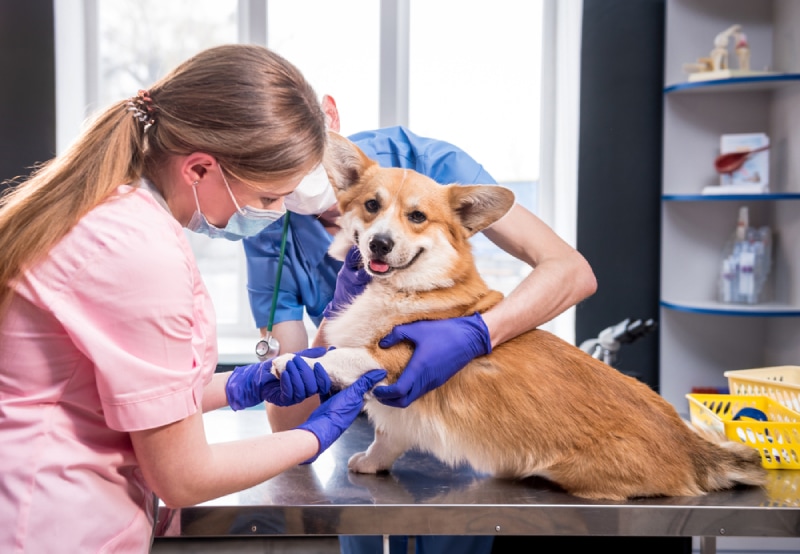
If you have a passion for animals, you’ve probably thought of turning it into a career more times than you can count. When you look into the potential careers available, many are low-paying or limited unless you have a degree or certification.
Going into the field of veterinary nursing can open up a window of opportunities in various settings for you. In this article, we will discuss how to become a veterinary nurse and where you can go in your career.

What Is a Veterinary Nurse?
A veterinary nurse is the same as a veterinary technician. That means you have a series of duties appointed by a licensed veterinarian to carry out daily. You can perform lots of tasks but there are others that must be left to the vet.
Generally, veterinary nurses handle:
As a vet tech, you can work in a variety of settings or move on to get further specialization, such as anesthesia, wildlife rehabilitation, or laboratory animal care.


The 8 Steps to Becoming a Veterinary Nurse
1. Research the Career Outcomes
Before you finalize your choice, it’s crucial to research your potential career outcomes. Traditionally, vet techs work in a clinical setting—generally, a vet’s office where they care mostly for dogs and cats. However, that is just the tip of the iceberg.
You can go back to school to further your studies, especially in a particular skill, or move up the ladder at your place of employment. This creative field allows you to dip your toes into many facets of animal care.
Career Opportunities
Here are several career outcomes or areas of specialization for veterinary nurses. Here are a few places that employ technicians.
Career Titles
You can work as a standard veterinary nurse, but other roles branch out from this general role. Salaries for vet techs range quite a bit, falling into the bracket of $25,000 on the low end to $60,000 on the high end.
Emergency Veterinary Technician
As an emergency veterinary technician, you can expect to work with wounded or ill animals in an around-the-clock setting. Emergency care focuses on making veterinary treatment available at any hour.
This job certainly comes with its challenges and will keep you on your toes. You will have to deal with grief soundly, as you will see many heartbreaking and gruesome things.
On average, an emergency veterinary technician makes $58,000 a year.
Dietary Technician
If you are passionate about a dog’s diet and are very good at putting together plans, you might be interested in being a dietary technician. Humans have them, and so do our pets! You would focus on animal nutrition for various dietary needs.
On average, a veterinary technician nutritionist would make roughly $49,000 a year.
Veterinary Radiology Technician
A radiological veterinary assistant is one that has traditional veterinary tech courses with a specialization in radiology. When you work in radiology, you’re going to deal with a lot of imaging, so it is a much more task-focused job. This job is very good for someone who wants to dig deep in the pet medical field.
On average, a veterinary radiology technician makes roughly $36,000 a year.
Behavioral Technician
As the title might give away, a behavioral technician works with various breeds and personalities to achieve certain goals. While any veterinary technician can work in behavior, you might need additional certifications or training to land a job in this category.
On average, a veterinary behavior technician makes roughly $27,000 a year.
Laboratory Technician
A laboratory technician helps in laboratory settings to ensure all animals are cared for. This might include giving injections, changing bedding, feeding, bathing, exercising, and monitoring animals.
Typically, these are experimental animals, so it certainly will only be for some people, but these creatures still do need proper care from licensed individuals.
A veterinary laboratory technician makes approximately $32,000 per year.
Anesthesia Technician
An anesthesia technician will assist anesthesiologists with procedures. These technicians might prepare animals for anesthesia under the direction of a licensed veterinarian.
On average, veterinary anesthesia technicians make roughly $42,000 a year.
X-ray Technician
Veterinary X-ray technicians help restrain animals during imaging testing. They prepare animals large and small for diagnostic digital radiography examinations. All work must be done under the direct supervision of a veterinarian.
A veterinary X-ray technician makes roughly $40,000 a year.
Surgical Technician
As you can guess from the name, a veterinary surgical technician assists a surgeon during surgery. Say that five times fast. These jobs are very demanding and fast-paced. So, if you’re a quick thinker who can separate emotion from your work, you might want to look into it.
Surgical veterinary technicians make significantly more than certain other categories and require additional certifications or licensing, depending on your specialization.
On average, a surgical technician makes $59,000 a year.

2. Select Your School
Selecting your school is an incredibly important choice. You will have several options, from local colleges to online courses. However, some institutions are not fully accredited, and you might not be able to use your degree in your state the way that you plan to if you choose the wrong school.
In the United States, you must be licensed through the AVMA-CVTEA. Some schools offer partial accreditation, while others offer full accreditation. Depending on what your school offers, you will have to jump through more hoops to become fully accredited, so work closely with counselors to ensure you’re making the right choices.
It is important to try to find a fully accredited school. To date, there are very limited resources online to help potential veterinary technicians who are looking for a strictly computer-based learning experience.
Regardless of where you choose to study, veterinary licensing requires that you have hands-on experience in the medical field. If you do select a fully online school, you need to find internships or externships that can help you gain this experience during your studies.
Why Accreditation is Necessary
Accreditation is a standard that all those who earn their veterinary technician degree must meet. Each state will differ in terms of necessary schooling, schooling hours, and type of accreditation needed.
Accreditation lets potential employers know that you hold your license and have completed proof that you are prepared to join the field.
3. Contact Admissions
Once you decide on your school, it’s time to contact the admissions department. You can submit your application and necessary documentation, such as a high school diploma.
The admissions team will help you get on board, ensuring that you receive the appropriate financial aid, set up student loans, develop a payment plan, and enroll appropriately.
Financial aid is an incredibly important part of the schooling process. Many people do not have money to pay out of pocket for schooling and require a little assistance. Luckily, there are tons of financial aid options available to citizens.
FAFSA/PELL
First, you can apply for FAFSA (Free Application for Federal Student Aid). The FAFSA offers the PELL grant, which is a government-funded grant option for qualifying students. You can check for eligibility or apply on the FAFSA website.
Grants/Scholarships
You can also apply for other grants or scholarships available for your college. Your financial or admissions advisor will explain what is available to you and guide you on how to apply.
Student Loans
Student loans are always an option when you are enrolling in school. A typical credit score does not affect your eligibility for a student loan. Also, many student loans do not require repayment until 6 months after graduation, and you can set up payment plans to pay off the loan in installments.

4. Complete Necessary Steps to Enroll
After your payment information is sorted out, you must finish the enrollment process. You might be asked to come in for orientation, register for specific classes, take entry testing, and a variety of other tasks.
Be sure to complete all of your required documentation and work with the school to meet deadlines.
5. Go Through Your Schooling
To become a veterinary nurse, you must complete all required courses and schooling aspects successfully. Not only will you have to maintain a good grade point average, you also have to make sure you participate and meet your attendance expectations.
6. Prepare for Internships/Externships
A part of the veterinary technician degree requires hands-on experience when you take your official test. Often, schools need you to complete a certain number of hours at a veterinary practice, rescue, or shelter where you can be under the supervision of a licensed veterinarian.
You can get the basics down, really seeing the mechanics of how a vet’s office works. Putting these practices in motion can help you retain very crucial information for your upcoming test and will stick with you for many years in the field.

7. Complete the Necessary Licensing Requirements
Ultimately, your schooling aims to help you pass the exam required to practice veterinary care. Testing requirements are different from state to state, so it’s important to check with your area specifically.
Every State Is Different
Each state will have its own set of requirements to be a veterinary nurse. Do the necessary research to ensure you follow the correct steps to become licensed in your state before committing to school.
8. Start Your Job Search
Sometimes, you get lucky, and an office or facility you intern with will offer you a job. This is extremely useful for students, as it immediately provides a path into the workforce. However, if you did not secure a job, you can make a snazzy résumé and start submitting your application at places of interest.
Some companies will gladly train and work with new technicians on the field. However, some offices would like prior experience. Getting your dream job right away might be a little far off at first. But just keep trying and gain the experience needed.


Conclusion
Now, you have a little bit more direction when it comes to getting your veterinary nurse technician degree. Most states require an associate’s degree, while others require a simple certification. Regardless, many are required to take the same test in order to practice.
A veterinary nursing degree can be a very rewarding career with many opportunities. Some might require additional certifications or hands-on experience, but it is certainly a career with flexibility and growth potential.
Featured Image Credit: Try_my_best, Shutterstock
